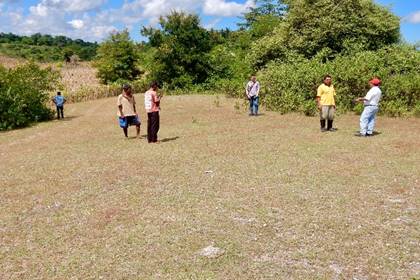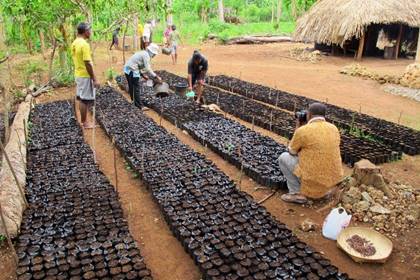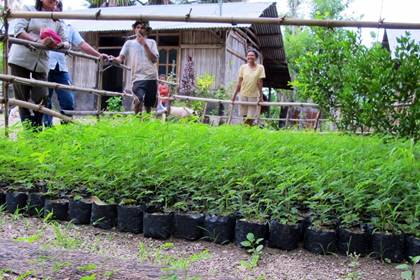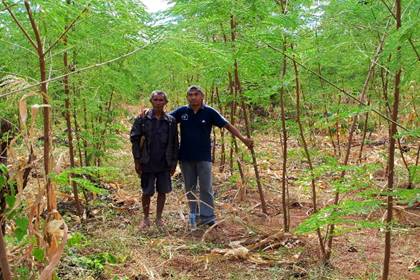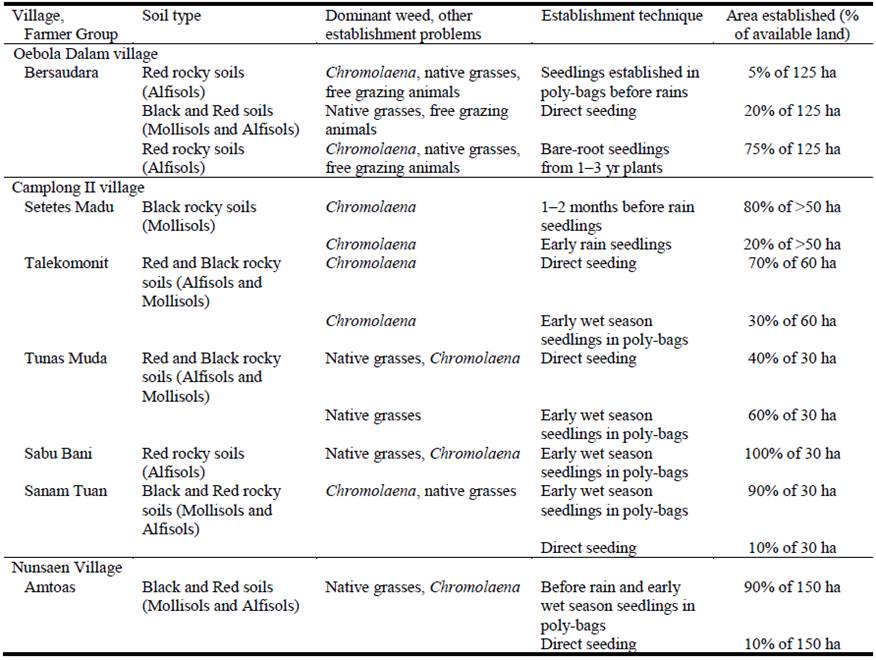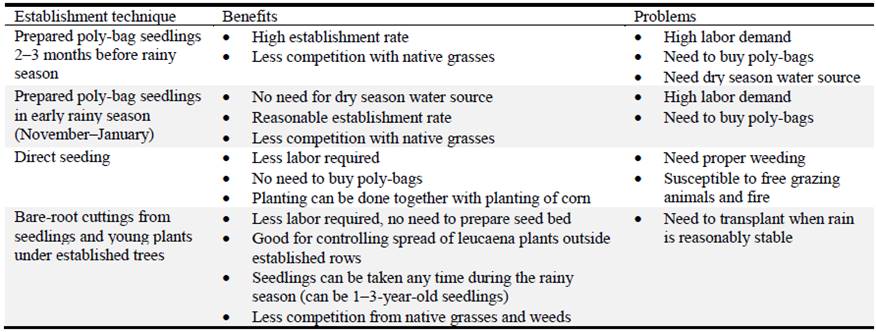Introduction
Adoption of the drought-resistant high-quality forage tree legume leucaena (Leucaena leucocephala cv. Tarramba) for cattle fattening is increasingly common in eastern Indonesia, especially in the Fatuleu subdistricts of West Timor. Successful establishment of Tarramba leucaena requires good knowledge of its establishment needs as well as practical skills. Earlier studies (Nulik et al. 2013) showed that the most successful method was planting of seeds in poly-bags 1‒2 months before transplanting seedlings into the field once the rainy season had commenced in November‒January. However, as the practice of planting Tarramba leucaena expanded, so did variation in site conditions. For instance, the Tunas Muda farmer group (Bilboto hamlet, Camplong II village, Fatuleu subdistrict), located in an area where availability of water was severely restricted during the dry season, waited until the early rainy season before poly-bag seedlings could be prepared for transplanting during February-March.
A review of modified establishment methods was conducted on several project sites where many new farmers had planted leucaena in West Timor, especially in Oebola Dalam and Camplong II villages in Fatuleu subdistrict, and in Nunsaen village in Central Fatuleu subdistrict. The objective was to observe how farmers had adapted their planting techniques to suit the various climatic and edaphic conditions and still achieve successful establishment of Tarramba leucaena.
Climate and soils of eastern Indonesia
Timor Island has a tropical wet and dry savanna climate (Köppen-Geiger classification: Aw) with a pronounced dry season. West Timor is characterized by a tropical monsoonal climate with erratic rainfall patterns (Table 1), often leading to plant establishment failures (Nulik 1994) even when establishment practices may have been conducted appropriately.
Timor Island was formed from coral uplift, and thus the main parent material of the soils is limestone rock. This parent material has led to the formation of 2 main soil types, black (Mollisol) and red (Alfisol) soils (Mella and Mermut 2010) (Figure 1). Nulik et al. (2013) reported that the black sediment soils (black clays and sandy clays) gave the best early plant growth during the establishment of Tarramba leucaena.
Current establishment techniques
Unlike Amarasi district in West Timor (Piggin and Nulik 2005), the Fatuleu region traditionally involved free grazing of breeding cows on communal pastures, where farmers produced calves for sale but suffered high calf mortality and consequently low weaning outcomes (Dahlanuddin et al. 2019). Moreover, with the increasing human and livestock populations, especially cattle, degradation of native pastures has become significant with extensive invasion by the unpalatable weed Chromolaena odorata (Figure 2). The introduction of Tarramba leucaena into the region was deemed the best solution to improve the livelihoods of poor farmers () by greatly increasing productivity of their cattle herds, and therefore cash flow to families, while simultaneously controlling the invasion of the unpalatable Chromolaena.
Thus expansion of programs to foster adoption of the legume was encouraged. In response to differing site conditions we observed that farmers had modified their establishment techniques according to their particular farm situations, i.e. some prepared seedlings in poly-bags (Figures 3 and 4) for planting in the early wet season, some direct-seeded leucaena while sowing corn (Figure 5), while others used ‘bare-root’ planting material derived from seedlings or plants up to 2‒3 years old (Table 2), which are dug out from under established tree rows and stripped of small branches and leaves. The benefits and problems associated with each establishment technique are described in Table 3.
Conclusions
We found that farmers modified their planting techniques for establishment of Tarramba leucaena in West Timor in response to conditions at specific locations. These modified planting methods included: (i) preparation of seedlings in poly-bags early in the rainy season (December‒February); (ii) direct seeding with corn early in the rainy season; (iii) and planting of bare-root seedlings obtained from under the established tree rows. The last technique was successful in Oebola Dalam village. Nevertheless, the best outcome was confirmed as transplanting of pre-prepared poly-bag seedlings 2‒3 months before the onset of the rainy season. The review also confirmed that plant growth was best on black soils derived from coral limestone soil (Mollisols) compared with growth on the red Alfisols in the region.















